RAISING BASIL(S)
/9 Comments/in Gardening/by Lee ReichContinuing Education
“No occupation is so delightful to me as the culture of the earth, & no culture comparable to that of the garden. Such a variety of subjects, some one always coming to perfection, the failure of one thing repaired by the success of another, & instead of one harvest a continued one thro’ the year. Under a total want of demand except for our family table I am still devoted to the garden. But tho’ an old man, I am but a young gardener.”
That’s what Thomas Jefferson wrote to Charles Willson Peal on August 20, 1811. Mr. Jefferson had it right. One thing, among many other, that makes gardening so rewarding for me is that there’s always something new to learn about plants and their cultivation. 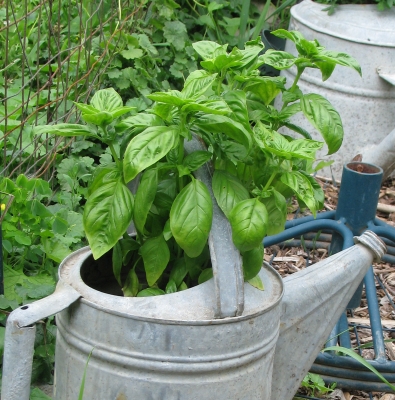
Take basil, for instance, which I, like many of you, have grown for many years. I’ve always been satisfied with a good harvest, enough for adding pizazz to summer salads and for preserving — dried, or frozen as pesto — for winter. But basil growing became more involved some years ago after a seed company sent me sample packets of a few varieties of basil, and then I spoke with some commercial herb growers.
The Lineup
In spring, I planted short rows of all the varieties I had, with a plastic tag at the head of each row. The tags were unnecessary, for no two varieties looked alike and I could have deduced the variety names by the catalogue descriptions. 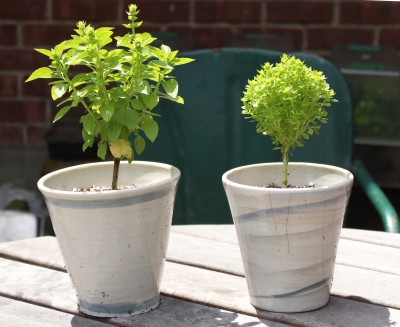
Flavor has always been my reason for growing basil, and I wondered just how different each variety would taste from its neighbor one row over. So I picked leaves of each variety and nibbled them. I rubbed their leaves between my palms, then inhaled deeply their aromas. I invited visitors to sample each variety, and as they sampled I badgered them with questions and jotted down notes. A pasta dinner was needed so we could evaluate each type of basil made into a pesto sauce. What torture!
There actually were differences in taste between the basils. The variety called Sweet lived up to its name with a mild flavor. The similarly mild flavor of Napolitano had the slightest hint of licorice; that of Spicy Globe, the slightest suggestion of mint. Progressively stronger in flavor were Lettuce Leaf, then Fino Verde. The taste of Genova was strong, bordering on acrid. Syracusa was one of the best — strongly aromatic, yet smooth to the palate.
I also grew some of the newer varieties resistant to downy mildew disease. Basil downy mildew is a relatively newcomer here, making itself seen by causing a slight yellowing of the leaves, with purple fungal spores on leaf undersides.
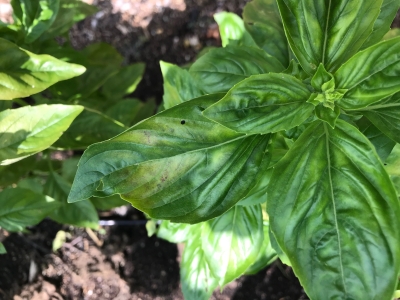
Basil downy mildew, top of leaf
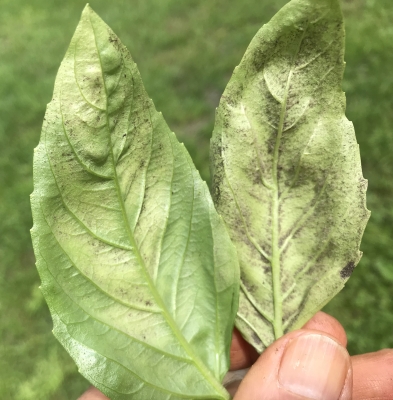
Basil downy mildew, leaf underside
I’ve got little more to say about those varieties because none of their flavors were notably better or as good as the non-resistant varieties, because the disease rarely shows up here, and because it can be controlled with abundant sunlight and good air circulation, and by avoiding infected plants, leaves, or seeds. What’s more, disease resistance is a matter of degree, and various degrees might also exist among the varieties not bred as such.
So, Which to Grow
Honestly, though, the differences in flavor among the tasty varieties were not dramatic; rather, they were subtle nuances of the familiar basil flavor. And tasting a few varieties does put objectivity on shaky ground. Maybe even the order of tasting is important.
So which is the best variety of basil? This brings us back to the striking difference in appearance between the varieties. Since the differences in taste were not that great, I usually choose a basil variety on the basis of plant size, and the size, color, shape, and texture of its leaves. If I want a basil with a very large leaf — perhaps large enough to wrap around a piece of fish to bake — I’ll grow Mammoth.
For drying or pesto, I like a variety with a lot of leaf and a minimum of stem. (The dried stems are useless; they’re basil-flavored twigs.) So any variety except small-leaved Fino Verde or Spicy Globe would be suitable for pesto.
For eating fresh in salads, even the small-leaved varieties are okay, since the fresh, young stems are tender. One of the purple-leaved varieties could be used fresh to add a splash of color in salads.
I might grow some basils just for decoration, even if they had no culinary use. Spicy Globe basil, planted close together, makes soft, green mounds resembling a miniature boxwood hedge — a nice border for a terrace or a flower garden. The deep purple color of Dark Opal would contrast nicely with bright yellow and orange zinnias in a sunny flower border. Purple Ruffles could be used for a more frilly effect. The large-leaved, green basils make an island of lime-green if massed together, with a texture dictated by the leaves of the variety chosen: smooth and shiny, wrinkled, or ruffled.
And who knows, maybe I’ll grow certain basil varieties just for the musical sounds of their names. When someone innocently asks, “What kind of basil is that?” I might gesticulate and sing, “Genova Profumatissima,” “Syracusa,” or “Fino Verde Compatto.”
WISE AND NOT SO WISE
/5 Comments/in Gardening, Vegetables/by Lee ReichA lot about this year’s vegetable garden warrants my patting myself on my back; other things warrant a nuggy (virtually impossible unless I was double-jointed). Let’s start with the pat-worthy stuff. Perhaps you’ll find some of it useful in your vegetable garden. Perhaps you’ll want to comment on it.
Good Moves
Sweet corn is one of my favorite vegetables, both fresh in summer, and frozen in winter. Evidently, chipmunks are also fans. I plant sweet corn — the old variety Golden Bantam — in hills (clumps) of three stalks per hill, the hills eighteen inches apart in the row, with two rows running the length of each three-foot-wide bed. I spread out the harvest with four plantings, the first on about the average date of the last frost, mid-May, and the last planting the end of June.
With a variation on traditional corn planting — “one for the rook, one for the crow, one to rot, and one to grow” goes the old saw — I drop five rather than four seeds per hole. 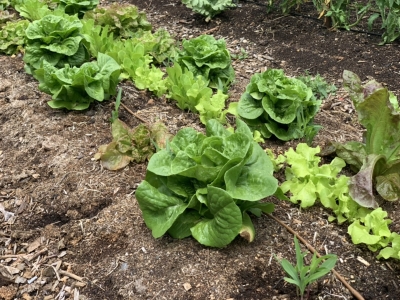 Seed is cheap. Unfortunately, those extra seeds merely gave chipmunks more to eat in that first planting. So . . .
Seed is cheap. Unfortunately, those extra seeds merely gave chipmunks more to eat in that first planting. So . . .
For subsequent plantings I sprinkled a mixture of cayenne pepper and cinnamon over the seeds in each planting hole. Although birds can eat hot pepper, furry animals generally, my dog Daisy excepted, cannot. I figured the chipmunks wouldn’t like the taste of cinnamon and/or it would mask any aroma from the corn seeds. The result: success.
Pests threatening my onions and leeks arrived here on the farmden just a few years ago. Leek moth is one of them and thrips possibly another. Leek moth flies to lay its eggs in early spring, and thrips overwinter in debris. Another pest severely stunted last year’s onions, but neither I nor a university vegetable specialist could find anything odd about the roots, tiny bulbs, or leaves on which to lay blame.
Thoroughly cleaning up debris, which I do for all beds anyway, and covering the bed with fine mesh should keep leek moth, thrips, and possibly other pests at bay. A wire frame to support a large piece of organza fabric, with the organza clothespinned tightly near ground level did the trick. The leeks and onions look healthy and vigorous.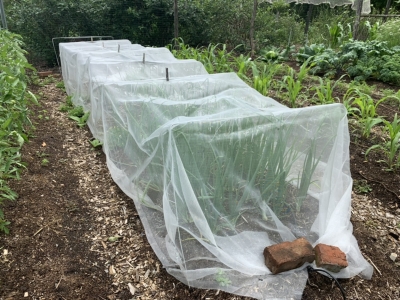
A Successful Makeover
The need for a bold makeover of my south vegetable garden is embarrassing, but I’ll come clean. For some reason I oriented beds in that garden, created in 1997, east and west. I should have know better. It was a more favorable location for the two gates, but that’s not a good excuse. Tall plants in east-west beds shade shorter plants in those and nearby beds throughout the day. So whenever possible, north-south, or nearly north-south, beds are best.
Last fall, with some help from friends, I raked soil in the beds and wood chipped paths as level as possible. (My beds aren’t raised beds, but they do slowly rise after decades of annual slatherings of an inch or more of compost.) 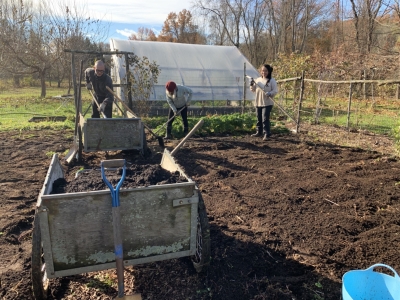 We rolled out gray resin paper to suppress weeds sure to sprout in the newly disturbed soil, then topped the paper with compost in the beds and wood chips in the paths.
We rolled out gray resin paper to suppress weeds sure to sprout in the newly disturbed soil, then topped the paper with compost in the beds and wood chips in the paths.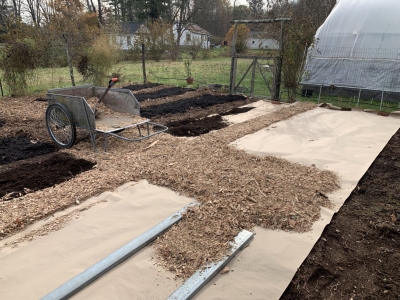
It’s a young garden again! Sort of. When planting, I can feel the difference in the ground from where a bed crosses regions that were once paths versus those that were beds. But the soil will get better every year, and the beds now run the better direction. Only one garden gate now, though.
Everything Not Always Rosy
Not all is always rosy down here on the farmden. Flea beetles, as expected, attacked my eggplants. I could have netted the eggplants also, but I was foolishly banking on hope.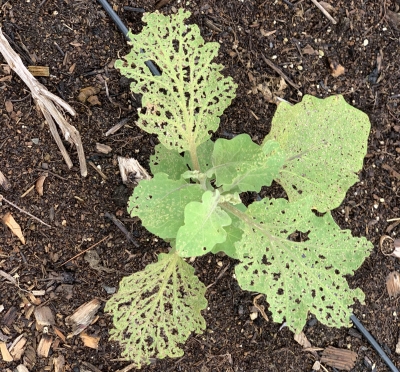 I’ll admit to spraying the organic pesticide Pyganic while waiting for the eggplants to outgrow the damage.
I’ll admit to spraying the organic pesticide Pyganic while waiting for the eggplants to outgrow the damage.
The other pest here is a weed, creeping woodsorrel (Oxalis corniculata). The straight species grows tall and is very easy to weed out. No problem.
The problem child is the purple-leaved variety (Oxalis corniculata var. atropurpurea) which blends in with the soil and hugs the ground in spreading mats. 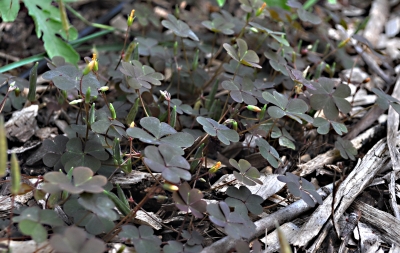 It responds favorably (for me, not it) to sprays of household strength vinegar or any of the other organic herbicides whose active ingredient is ammonium nonanoate, such as Ortho® GroundClear® Weed & Grass Killer or the more benign sounding BioSafe Weed & Grass Killer.
It responds favorably (for me, not it) to sprays of household strength vinegar or any of the other organic herbicides whose active ingredient is ammonium nonanoate, such as Ortho® GroundClear® Weed & Grass Killer or the more benign sounding BioSafe Weed & Grass Killer.
And finally, we come to drip irrigation, a watering technique on which I’ve heaped tons of praise for saving water, for limiting weeds, for healthier plants, and for being easily automated. This last quality can cause a problem. A few years ago I thought a spring had sprung it my field; it was an old main line that was still in line and spewing out water below ground. Another year plants in a couple of beds seemed to languish as drier weather moved in; the underground connection of some drip lines had disconnect from the main line. Yet another time, water was pouring out of an unplugged end of a drip line. Or, last year the battery died on one of the timers; most affected were two small rosemary plants, trained as small trees, many of whose leaves and stems dried up, dead.
This spring, it was, first, the main water source, which is from a shallow well, clogging the filter. And then, a piece of hose running from the well pump to the main line developing a kink.
All these irrigation glitches were easily fixed once I noticed them. And there’s the key. My very smart phone now reminds me to spend the few minutes required to check the drip irrigation system every Monday.
FRUIT VS SHOOT
/0 Comments/in Pruning/by Lee ReichNote 1: I have some plants leftover from this past weekend’s plant sale here at the farmden. Contact me by June 24, 2022 if you’re interested in purchasing to pick up any white currant, black currant, fig, or gooseberry plants (a number of varieties of the latter two).They’re all discounted at 25% off.
Note 2: My farmden is open for a Garden Conservancy Open Day on Saturday, June 18, 2022 from 2 p.m. to 5 p.m. Registration is required, here.
Shoots versus Fruits
I’ve been playing around with the orientation of some of my trees’ branches to influence how they grow. Branches pointed skyward generally are inherently vigorous, giving rise to long shoots, especially from their topmost buds. At the other extreme are branches oriented horizontally. They’re generally weak-growing, and tend to produce fruit buds rather than vigorous shoots and leaves. The cool thing is that if you or I change branch orientation, it changes the growth and fruiting habit of that branch.
Bending and tying branches is a good way to balance shoot growth and fruiting, especially of apple and pear trees. Both types of growth are needed. The fruits for us to eat, and the shoots to “feed” the fruit and to provide places on which to hang the fruits. Shoot growth is also needed to periodically replace old wood.
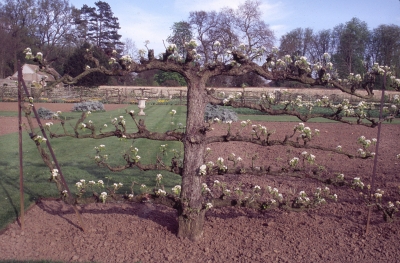 Branch bending to regulate growth and fruiting is especially evident with an espalier, which is a tree grown in an orderly, usually two dimensional form. Lurking behind the many forms, fanciful and otherwise, for espaliers is an appreciation for their effects on growth and fruiting.
Branch bending to regulate growth and fruiting is especially evident with an espalier, which is a tree grown in an orderly, usually two dimensional form. Lurking behind the many forms, fanciful and otherwise, for espaliers is an appreciation for their effects on growth and fruiting.
Achieving Balance
Backyard apple and pear trees commonly put too much of their energy into shoot growth, a problem that can be exacerbated by overly enthusiastic pruning and over-fertilization. One way to coax an overly vigorous tree into bearing is by pulling upright branches downward, affixing them in that direction. This may seem an unnatural way to treat a plant, but it does help a tree to get started fruiting. Once fruiting begins, the weight of the fruit will keep branches down.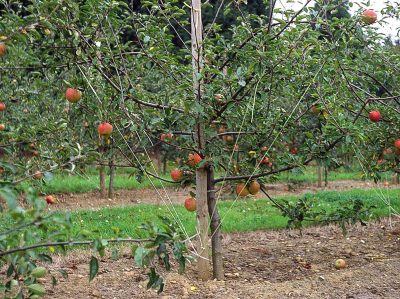
Sometimes fruit pulls a branch down so much that it’s too fruitful and needs invigoration. Asian pears are prone to bearing too heavily too early in their life, especially if grafted on dwarfing rootstocks; the result is a stunted tree. The cure is to drastically cut drooping branches back to more upward growing — and, hence, vigorous — side shoots. Or to stake branches into more upright positions.
Bending down branches spreads them, which, along with correct pruning, also lets all branches bathe in sunlight. With many upright growing branches, the interior of a tree becomes too shaded to produce fruit buds or even leaves. 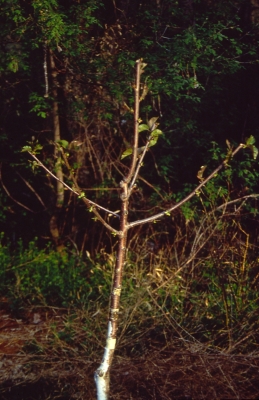
Branches that are spread at an early age make wide angles with the trunk. That wide angle attachment becomes a strong juncture, one that will not break when eventually weighted down with fruit, as often occurs with branches having narrow crotch angles.
Practical Matters: How to Do It
On very young trees which are still forming their main branches around the trunk, I start spreading the new shoots when they are just a few inches long. After bending a shoot carefully so as not to break it, I hold it in that position by snapping a spring-type clothespin on the trunk with the tail of the clothespin holding the shoot down.  Another way to hold this wide angle is to press one end of a toothpick into the shoot and the other into the trunk, just enough to keep the toothpick in place.
Another way to hold this wide angle is to press one end of a toothpick into the shoot and the other into the trunk, just enough to keep the toothpick in place.
For older branches, I use either a stiff wire or a length of wood with a brad driven in each end. (I’ve previously removed the brad’s head and sharpened what remains.) 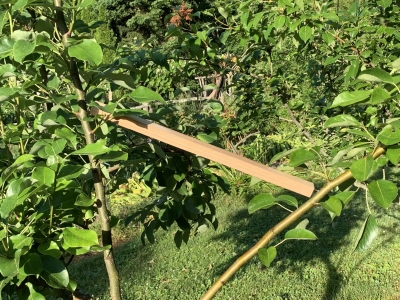 Tying a string around a branch, and then to a weight on the ground or to the tree’s trunk is another way to pull a branch down. Or, you can affix a weight right to the branch. For instance, glue a clothespin to a rock, then clip it to the branch.
Tying a string around a branch, and then to a weight on the ground or to the tree’s trunk is another way to pull a branch down. Or, you can affix a weight right to the branch. For instance, glue a clothespin to a rock, then clip it to the branch.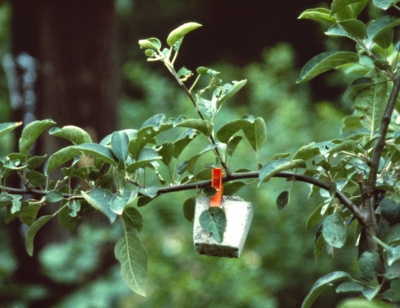
After a few weeks, the ties or weights or clothespins can be removed. The branches will stay in place.
Ideally, re-orienting the branches of apple and pear trees achieves a favorable balance between shoots and fruits. To this end, strive for about a sixty degree angle to the trunk. I try to keep the branch straight as it is oriented to this angle. If the branch has a bow in it when pulled down, overly vigorous shoots are apt to grow from buds at the topmost part of the bow.
Don’t expect immediate payback for all this care and effort. A year or more might elapse before an apple or a pear tree forms fruit buds, and fruit buds form fruit buds the season prior to actual fruit production. It’s worth the effort in the long term.

